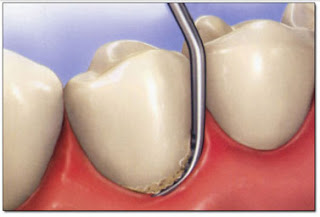 What is Teeth Scaling?
What is Teeth Scaling?
Do you ever wonder exactly what your dental hygienist is doing during a routine cleaning? Of course, they floss and polish your teeth as the last step but what about when they use the tool with the metal hook to scrape the bottoms of your teeth near the gum line? They also use compressed air and water to help get the job done. This process is referred to as teeth scaling, a crucial step in deep cleanings that can help prevent and treat periodontist (gum disease) by removing built-up plaque and tartar.
A study by the Centers for Disease Control says that 47.2 percent of people in the United States suffer from mild, moderate or severe periodontist. Periodontist, also known as gum disease or gingivitis at a certain stage, is caused by bacteria-ridden plaque and tartar that sits near the gum line. If plaque isn’t properly removed regularly, it releases toxins that attack gum tissue. Symptoms of periodontist include red, swollen gums that are sensitive and bleed when brushed. Other symptoms include gums that are receding or pulling away from the teeth ultimately resulting in elongated looking teeth.
A severe case of periodontist can lead to tooth loss and permanent damage to the jaw. However, if treated early the damage can usually be reversed by scaling or gum surgery. During a six-month check-up and teeth cleaning, if a patient is not consistently brushing and flossing, expect the hygienist to be scaling teeth to remove the build-up of plaque and tartar that is cemented on the teeth and cannot be removed with just brushing and flossing at that point. That is one of the many reasons it is extremely important to get your teeth regularly cleaned by a professional and to properly brush and floss your teeth and gums twice a day.
How the hygienist does the job
There are a few instruments used to scale teeth and your dental hygienist may use depending on the situation. The most common instrument is the hand-held metal scaler. The hygienist will use this instrument to manually remove the plaque and tartar from the teeth by using both the sharp and blunt ends of the scaler. The sharp end is used to scrape build-up on the teeth and the blunt end is used to reach under the gum line and remove plaque without harming the gums.
A sonic scaler and an ultrasonic scaler are the other tools the hygienists use. A sonic scaler sprays compressed water and air, which allows the hygienist to break up the tartar and plaque and then with the ultrasonic scaler an electromagnetic field is generated to chip away at build-up with sound vibrations. The hygienist selects the appropriate tools, after examining the severity of the build-up and assessing the patients’ health. For example, if a patient has a pacemaker, the hygienist should not use an ultrasonic scaler because the electromagnetic field causes pacemaker malfunctions.
At Artistic Dental, we recommend getting your teeth scaling and deep cleaned every six months. When you skip appointments, build-up of plaque and tartar is more likely. Dr. Dougherty and Dr. Adhikari, along with our highly-trained team of hygienists believe that proper cleanings are the best way to fight periodontist and gum disease. To make an appointment call (602)-840-5400.
